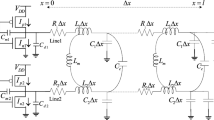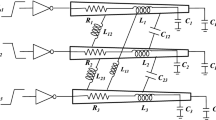Abstract
This chapter introduces a novel unconditionally stable FDTD (US-FDTD) model for the performance analysis of on-chip interconnects. It is observed that the stability of the proposed US-FDTD model is not constrained by the CFL condition and is therefore unconditionally stable. The accuracy of the proposed model is validated against the conventional FDTD model. It is observed that the US-FDTD model is as accurate as the conventional FDTD model while being highly time efficient. Moreover, the performance of Cu interconnect is compared with MWCNT and MLGNR interconnects under the influence of crosstalk.
Access this chapter
Tax calculation will be finalised at checkout
Purchases are for personal use only
Similar content being viewed by others
References
Zhang J, Friedman EG (2006) Crosstalk modeling for coupled RLC interconnects with application to shield insertion. IEEE Trans VLSI Syst 14(6):641–646
Koo KH (2000) Comparison study of future on-chip interconnects for high performance VLSI applications. Ph.D. thesis. Stanford University, United States
Das D, Rahaman H (2011) Analysis of crosstalk in single- and multiwall carbon nanotube interconnects and its impact on gate oxide reliability. IEEE Trans Nanotechnol 10(6):1362–1370
Livshits P, Sofer S (2012) Aggravated electromigration of copper interconnection lines in ULSI devices due to crosstalk noise. IEEE Trans Dev Mater Reliab 12(2):341–346
Jiang LL, Mao JF, Wu AL (2006) Simplistic finite-difference time domain method for Maxwell equations. IEEE Trans Magn 42(8):1991–1995
Bawa S, Sharma GK (2002) A parallel transitive closure computation algorithm for VLSI test generation. In: Proceedings of the 6th international conference on applied parallel computing advanced scientific computing, London, UK, pp 243–252
Farahat N, Raouf H, Mittra R (2002) Analysis of interconnect lines using the finite-difference time-domain (FDTD) method. Microw Opt Technol Lett 34(1):6–9
Taflove A (1995) Computational electrodynamics. Artech House, Norwood, MA
Strikwerda JC (1989) Finite difference schemes and partial differential equations. Brooks/Cole, Pacific Grove, CA
Liang F, Wang G, Lin H (2012) Modeling of crosstalk effects in multiwall carbon nanotube interconnects. IEEE Trans Electromagn Compat 54(1):133–139
Li XC, Ma JF, Swaminathan M (2011) Transient analysis of CMOS gate driven RLGC interconnects based on FDTD. IEEE Trans Comput Aided Des Int Circuit Syst 30(4):574–583
Lee YM, Chen C (2001) Power grid transient simulation in linear time based on transmission line-modeling alternating-direction implicit method. In: Proceedings of the IEEE international conference on computer aided design, ICCAD, USA, pp 75–80
Namiki T (1999) A new FDTD algorithm based on alternating-direction implicit method. IEEE Trans Microw Theory Techn 47(10):2003–2007
Wang W, Liu PG, Qin YJ (2013) An unconditional stable 1D-FDTD method for modeling transmission lines based on precise split-step scheme. Prog Electromagnet Res 135:245–260
Kong Y, Chu Q, Li R (2013) Two efficient unconditionally-stable four-stages split-step FDTD methods with low numerical dispersion. Prog Electromagnet Res B 48:1–22
Sun C, Trueman CW (2003) Unconditionally stable Crank-Nicolson scheme for solving two-dimensional Maxwell’s equations. Electron Lett 39(7):595–597
Tan EL (2008) Efficient algorithms for Crank-Nicolson-based finite difference time-domain methods. IEEE Trans Microw Theory Tech 56(2):408–413
Tang M, Mao JF (2008) A precise time-step integration method for transient analysis of lossy nonuniform transmission lines. IEEE Trans Electromagnet Compat 50(1):166–174
Afrooz K, Abdipour A (2012) Efficient method for time-domain analysis of lossy nonuniform multiconductor transmission line driven by a modulated signal using FDTD technique. IEEE Trans Electromagnet Compat 54(2):482–494
Jia L, Shi W, Guo J (2008) Arbitrary-difference precise-integration method for the computation of electromagnetic transients in single-phase nonuniform transmission line. IEEE Trans Power Deliv 23:1488–1494
Kang SM, Leblebici Y (2003) CMOS digital integrated circuits: Analysis and design,” 3rd edn. Tata McGraw-Hill
Kantartzis VN, Tsiboukis TD (2008) “Modern EMC analysis techniques volume I: Time-domain computational schemes. Synth. Lectures Comput. Electromagn., 1st edn., pp 1–224
Kumar VR, Alam A, Kaushik BK, Patnaik A (2015) An unconditionally stable FDTD model for crosstalk analysis of VLSI interconnects. IEEE Trans Compon Packag Manuf Technol 5(12):1810–1817
Maxwell 2D student version, Ansoft Corp., Pittsburgh, PA (2005)
FastHenry version 3.32 (2011) http://www.fastfieldsolvers.com
Tan MLP, Arora VK, Saad I, Ahmadi MT, Ismail R (2009) The drain velocity overshoot in an 80 nm metal-oxide-semiconductor field-effect transistor. J Appl Phys 105(7):074503-1–074503-7
Kahng AB, Muddu S, Vidhani D (1999) Noise and delay uncertainty studies for coupled RC interconnects. In: Proceedings of the IEEE international ASIC/SOC conference, Washington, DC, pp 3–8
Sentaurus user manuals (2015) Synopsys Inc. Mountain View, CA, USA
Author information
Authors and Affiliations
Corresponding author
Rights and permissions
Copyright information
© 2016 The Author(s)
About this chapter
Cite this chapter
Kaushik, B.K., Kumar, V.R., Patnaik, A. (2016). An Efficient US-FDTD Model for Crosstalk Analysis of On-Chip Interconnects. In: Crosstalk in Modern On-Chip Interconnects. SpringerBriefs in Applied Sciences and Technology. Springer, Singapore. https://doi.org/10.1007/978-981-10-0800-9_6
Download citation
DOI: https://doi.org/10.1007/978-981-10-0800-9_6
Published:
Publisher Name: Springer, Singapore
Print ISBN: 978-981-10-0799-6
Online ISBN: 978-981-10-0800-9
eBook Packages: EngineeringEngineering (R0)




